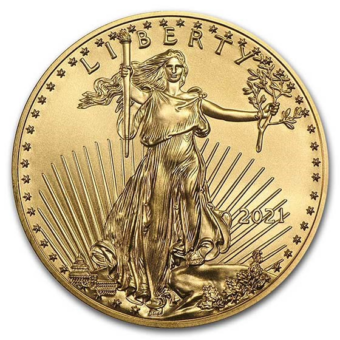Here’s What Happened in the Gold Market This Week - Day by Day
This week had a lot going on, especially in the financial markets.
On Monday, the price of gold slightly increased as people braced for a hectic week of economic reports and data. Despite the potential uncertainty, Saxo Bank believed the gold market was sturdy and predicted its value would continue to rise because of factors like a weak dollar, the risk of recession, demands from central banks, ongoing inflation, and global political tensions. Also on Monday and Tuesday, the Treasury Department planned bond auctions.
On Tuesday, there was a drop in the headline inflation rate, but it didn't cause much of a stir in gold prices or the stock market. Instead, the value of bonds and the dollar fell significantly. Fred Hickey from High Tech Strategist argued that this could be the perfect environment for gold prices to reach record highs, especially if the overvalued stock market starts to fall. He noted that gold tends to do well when stocks are struggling, as happened in the 1970s and 2000s.
On Wednesday, gold and silver prices didn't change much as people waited for another U.S. inflation report and the results of the Federal Open Market Committee (FOMC) meeting. As a result, gold increased a bit, while silver stayed pretty much the same. Global stock markets were a mixed bag. The Federal Reserve was expected to pause their interest rate hikes, especially after Tuesday's Consumer Price Index report showed a yearly inflation increase of 4.0%, which was expected. There was also anticipation for the European Central Bank's meeting on Thursday, where they were expected to increase their main interest rate.
On Thursday, both gold and silver prices fell considerably, with gold hitting a three-month low. The U.S. Federal Reserve didn't increase interest rates as expected, but they maintained a "hawkish" stance, meaning they might increase rates in the future. This put pressure on gold and silver prices, and led to a stronger dollar and higher U.S. Treasury yields. At the same time, China's central bank cut a key interest rate after receiving some negative economic data.
On Friday, gold and silver prices went up in the US due to the weakening US dollar, with gold and silver prices now at $1,979.80 and $24.26 respectively. Despite a busy economic week, today is quieter and US stock markets are set to open slightly higher. US traders and investors are looking forward to the upcoming long weekend due to the new Juneteenth holiday. Meanwhile, Europe's consumer prices increased as expected by 6.1% compared to last year, and US Secretary of State, Blinken, is going to China this weekend in an effort to improve US-China relations. Furthermore, the US dollar value has dropped slightly, crude oil prices have risen a bit to $70.75 per barrel, and the return on 10-year US government bonds is around 3.7%.
JPMorgan Encourages Increased Gold Investments
As economic instability grows, investors are seeking security in gold, and prominent banks like JPMorgan Chase are recommending a tactical move towards this valuable asset. Given the worries about the US debt limit, increased chance of a recession, and tightening cash flow, JPMorgan is advising investors to decrease their focus on stocks and boost their investment in gold and cash. The inherent protective qualities of gold, such as its ability to safeguard against heightened risks, poor stock performance, and fluctuating economic conditions, have garnered substantial interest.
According to a survey by the World Gold Council, about 24% of central banks plan to enhance their gold reserves this year, mirroring the viewpoint of major financial institutions. Central banks' net purchases of gold hit a 55-year peak in 2022, and 2023 is seeing a sped-up trend of gold accumulation by large banks.
Is Gold Stuck In a Holding Pattern?
Huw Roberts, Head of Analytics at Quant Insight, has stated that the gold market is complex and calls for vigilant investors. Despite being slightly undervalued, gold is in a "wait-and-see" phase with a neutral outlook. Interest rate volatility, primarily driven by bond supply concerns and rising debt levels, is the most significant factor influencing the gold market and the wider financial landscape. If interest rate volatility decreases, gold prices could increase.
Roberts suggests that an unstable bond market due to a supply surplus could impact both the equity markets and gold prices negatively. He also points out that potential risk events and widening credit spreads due to economic fears could renew gold's appeal as a safe haven. Despite the intricate market situation, he suggests taking a long position in gold.
Gold Rebounds from Three-Month Low Amid Dollar and Yield Weakness
Gold prices managed to recover from a three-month low on Thursday, as the U.S. dollar and bond yields fell after the release of U.S. economic data. The data provided some relief for investors following the Federal Reserve's decision to pause, yet maintain a hawkish stance, on interest rates. Spot gold increased by 0.78% to $1,958.1844 per ounce after hitting its lowest point since March 17. Meanwhile, U.S. gold futures rose slightly by 0.1% to settle at $1,970.7.
Data revealing unchanged U.S. initial jobless claims for the past week and a lower than expected industrial output, which fell by 0.2% in May, prompted corrective price action and short covering, according to Jim Wyckoff, a senior analyst at Kitco. However, the long shadow of Wednesday's FOMC meeting and the three-month low hit overnight continue to exert pressure on gold prices. The Federal Open Market Committee (FOMC) kept interest rates steady but suggested that borrowing costs may still need to rise by up to half a percentage point by the year-end.
Is Silver Really Underpriced? Some Experts Think So
Despite the mainstream narrative often focusing on price inflation when considering the bullish case for silver, an impending supply shortage in the silver market is being overlooked. High demand for silver in the growing solar power industry will likely exacerbate supply constraints in coming years, a reality not currently reflected in silver's price, which stands at $24 to $25 an ounce. Demand for silver is breaking records, yet mine output fell by 0.6% in 2022, resulting in a significant market deficit.
The rising demand for solar power is a key driver for silver demand, with the International Energy Association predicting investment in the solar power industry to outstrip that in oil production by 2023. Research suggests that by 2027, solar manufacturers will require over 20% of current annual silver supply. Despite the industry developing more efficient technologies that require less silver, increasing efficiency and a lack of viable alternatives imply a continued rise in silver demand, amid concerns about constrained supply. This could see the undervalued silver market experiencing substantial price surges.
What’s Going On Next Week?
Next week's economic calendar includes the following events:
Monday, June 19:
- Juneteenth Day holiday: All markets closed.
Tuesday, June 20:
- 8:30 am: Housing starts data will be released.
- 11:45 am: New York Fed President John Williams will speak.
Wednesday, June 21:
- 10:00 am: Federal Reserve Chair Powell will testify to a House panel.
Thursday, June 22:
- 8:30 am: Initial jobless claims data will be released.
- 10:00 am: Existing home sales data will be released.
- 10:00 am: Federal Reserve Chair Powell will testify to a Senate panel.
Friday, June 23:
- 8:30 am: S&P flash U.S. services PMI (Purchasing Managers' Index) will be released.





















